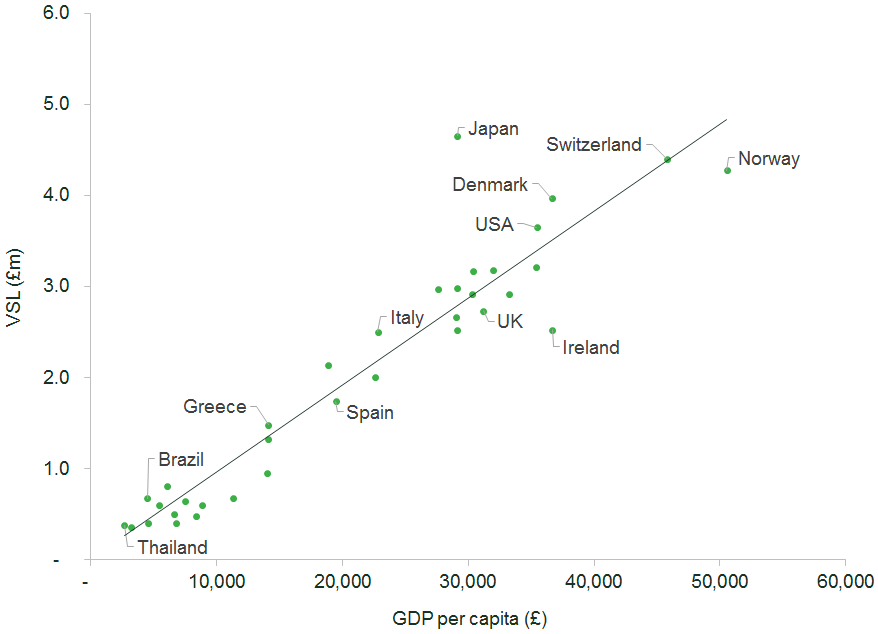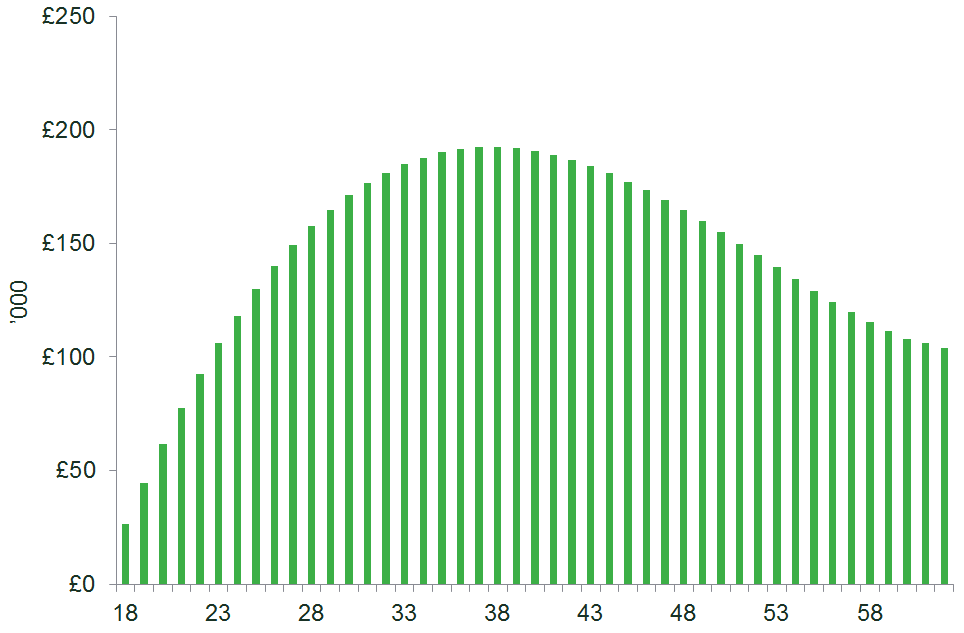You’re worth it! The economics of life valuation
What price a life? In personal, social, cultural and legal spheres we might not even pose the question; life is, after all, priceless. It might therefore be surprising to find economists employing values for prevented fatalities alongside financial costs in fields such as health, transport and environmental policy.
These economic ‘values of lives’ are employed wherever policymakers are confronted with a difficult trade-off between safety and other desirable features such as speed, deliverability or cost-effectiveness. Policymakers aim to achieve a balance by weighing up these concerns. If there is too little consideration for safety, lives may be needlessly put in danger. However, it is equally important to recognise that all human activity involves some degree of risk; if there is excessive concern for safety, worthwhile policy changes can become impractical or unaffordable. The VSL is not an attempt to directly evaluate the worth of a human life, but a tool that allows policymakers to strike a balance between too much and too little safety risk.
The VSL is defined as the value of reducing risk such that one statistical life is saved. The distinction between a statistical life and a particular life is important. In reality, decision-makers must consider the cost of reducing the risk to life by a small amount, but across a wide population. For instance, a safety programme might reduce the average risk of suffering a road accident fatality each year from 1 in 25 million to 1 in 50 million. To an individual, it is a tiny change, but spread across the population of the UK it will save one life every year, on average. VSL is inherently anonymous, statistical and impersonal—it is the value of an individual life, not an individual’s life.
Theory of life
Two approaches have been at the forefront of calculating these statistical values of life. Originally, research was centred on the human capital (HC) approach, which measures the VSL as the total lost future earnings of an individual.1 While it is straightforward to estimate accurately, the method lacks the ability to quantify the intangible elements, such as leisure and social interaction, which are hard to value but are nevertheless important.
A more recent method is the willingness-to-pay (WTP) approach. Unlike the HC approach, this does not ignore the unseen effects; instead, these are automatically fed into the result by asking participants to put a value on safety or health features that will reduce risks to their lives. The drawback is that this often yields a wide range of results depending on the method and environment used for the individual study. However, it is widely favoured in modern policy evaluation,[2] since it might be better to have an approximate estimate of the right value than an accurate estimate of a value that systematically excludes important elements.
The WTP approach is shown through the example of workers requiring a higher wage for taking on greater risk in the workplace. That is, in general, riskier jobs will carry a higher wage than those of a similar skill level but with less risk. For example, oil rig workers face a high level of risk at their workplace, so are paid more to encourage them to do the job. Alternatively, office workers face much lower risk, suggesting that, on a like-for-like basis, wages are lower. In effect, VSL can be estimated from the incremental amount of compensation that a worker requires in order to do a higher-risk job of a skill level similar to a lower-risk job.
Are we all the same?
A consequence of the WTP framework is that the VSL is different for different groups. For instance, the US Environmental Protection Agency encountered significant opposition in 2003 when its regulations attached a ‘senior discount’ of 37% to the VSL of people over 65.3 This and other variations of VSL throw up highly controversial questions about whether the lives of different groups of people should have the same value attached to them.
The main characteristics that have been studied are considered next.
Income
Under the WTP and HC approaches, income matters to the calculation of VSL: it is assumed that workers with a higher wage would pay more to prevent death as they would hold on to more income by doing so. This would suggest that VSL varies within a country. However, since VSL is interested in unidentified lives, any income adjustments nationally would be difficult and unpopular.
The effect of income differences on VSL across countries is more commonly researched than their effect within countries. VSL has been shown to strongly correlate with GDP per capita—that is, it rises in line with income per person.4 Figure 1 illustrates this, by showing that VSL in proportion to GDP per capita is roughly constant, at about 95 times GDP per capita.
Figure 1 Relationship between GDP per capita and VSL

Age
Under the WTP framework, the VSL might be expected to decline with age: as we get older, we have less of our life remaining. The full story is more complex, however. The VSL is influenced across the life cycle by an individual’s family and employment circumstances. Moreover, risk aversion may vary with age (as discussed below). Research suggests that an adult’s WTP increases to around age 40, before declining.5 With this in mind, a meaningful estimate of VSL should value what people place on each year of their life, known as the value of statistical life year (VSLY), which is explained further in the box below.

Using this approach alone might encourage policymakers to spend somewhat more on health and transport measures to reduce risks for young people, particularly children. While this may not be objectionable in itself, it is vital that decision-makers do not apply the framework too prescriptively. Factors such as the accumulated knowledge and expertise of older people, which would be lost to society in the event of a fatality, are not fully captured by the WTP framework. There is certainly no economic justification for neglecting the safety of older people.
Risk aversion
The underlying values that individuals give in these studies depend on how they personally price risk. Naturally, risk-averse people will have a higher VSL, as they will pay more to avert the presented risk of death. This has been used to suggest that workers in hazardous situations are less risk-averse, and so have a lower VSL.6
Altruism
The research on the impact of altruism on VSL is inconclusive, but it does raise some interesting findings. One is that VSL among parents has been found to be higher for their children than for themselves.7 This has led to the suggestion that young people’s VSL is actually higher than when measured conventionally, as the common approach assesses an individual’s WTP for their own risk reduction only, not their WTP to protect others.
Risky business
VSL will depend not only on the type of person, but also on the type of risk. Why, for example, was UK VSL assessed to be £1.2m in the 2005 UK Road Safety Bill,8 whereas independent research cites £2.7m (see Figure 1)? Why is it that some studies have shown that more feared risks, such as terrorism, produce VSLs up to twice as high as for common and predictable risks?9
The difference may be due to ‘dread factors’. This is the idea that, if a certain hazard is more feared, people will pay more to avert a given probability of occurrence than they would for a hazard that is less feared.
In the example of terrorism, the level of fear and uncertainty that surrounds the issue causes people to overvalue the risk of being victim to an attack, even if the probability presented is the same as for other risks. This might not result in unreasonable policy choices. Terrorism affects society not only through victims losing their lives, but also through the fear created from the sense that one’s community or country is under attack. In this sense, investment in anti-terrorism measures has value beyond the lives saved, with a disparate impact on people’s feeling of safety and wellbeing. The WTP framework captures this through individuals’ proportionately higher valuation of the risk involved.
In another prominent example, cancer has been shown to carry a large premium due to the fear caused by its often long and painful development period.10 In 2001, the UK Health and Safety Executive concluded that VSLs for cancer patients should be twice those for road accident victims.11
Concluding remarks
While the value of life may be an uncomfortable concept on the surface, it is an important tool when making policy decisions. Being able to use VSL numbers to evaluate infrastructure projects, healthcare programmes and environmental regulations, for example, is invaluable for governments worldwide. For instance, in the case of the 2005 UK Road Safety Bill, the use of VSL led to the implementation of a large package of road safety laws tackling drink-driving, speeding, driver fatigue and licensing fraud. Politicians will always be faced with such decisions, whether they concern a proposal to build a new hospital or a regulation for car safety equipment. In all cases, a trade-off has to be made between the costs and benefits of the proposal. VSL helps to enlighten this decision.
1 Kenkel, D. (2002), ‘Using estimates of the value of a statistical life in evaluating regulatory effects’, Department of Policy Analysis and Management, Cornell University, p. 4.
2 Andersson, H. and Treich, N. (2009), ‘The Value of a Statistical Life’, Swedish National Road & Transport Research Institute (VTI), Sweden.
3 Fialka, J. (2003), ‘EPA to stop “Death Discount” to value new regulations’, The Wall Street Journal, 8 May.
4 Miller, T. (2000), ‘Variations between countries in values of statistical life’, Journal of Transport Economics and Policy, 34:2, pp. 169–88.
5 Shepard, D. and Zeckhauser, R. (1984), ‘Survival versus competition’, Management Science, 30:4, p. 423.
6 See page 709 in Cropper, M. and Oates, W. (1992), ‘Environmental Economics: A survey’, Journal of Economic Literature, 30:2, pp. 675–740.
7 Andersson, H. and Treich, N. (2009), ‘The Value of a Statistical Life’, Swedish National Road & Transport Research Institute (VTI), Sweden.
8 Department for Transport (2005), ‘Road Safety Bill Regulatory Impact Assessment’, March.
9 Robinson, L.A., Hammitt, J.A., Aldy, J.E., Krupnick, A. and Baxter, J. (2010), ‘Valuing the risk of death from terrorist attacks’, Journal of Homeland Security and Emergency Management, 7:1.
10 Viscusi, W. (2011), ‘Policy Challenges of the Heterogeneity of the Value of Statistical Life’, Published Articles & Papers, paper 95.
11 Health and Safety Executive (2001), ‘Reducing risks, protecting people’, p. 65.
Download
Related

Ofgem’s RIIO-3 Sector Specific Methodology Decision
On 18 July 2024, Ofgem published its Sector Specific Methodology Decision (SSMD) for the forthcoming RIIO-3 price control period for electricity transmission (ET), gas transmission (GT) and gas distribution (GD) networks.1 This follows Ofgem’s consultation on the matter in December 2023.2 RIIO-3 will last for… Read More

The future funding of the England & Wales water sector: Ofwat’s draft determinations
On Thursday 11 July, Ofwat (the England and Wales water regulator) published its much anticipated Draft Determinations (DDs). As part of the PR24 price review, this sets out its provisional assessment of allowed revenues and performance targets for AMP8 (2025–30)—and will be of great interest to water companies, investors,… Read More

